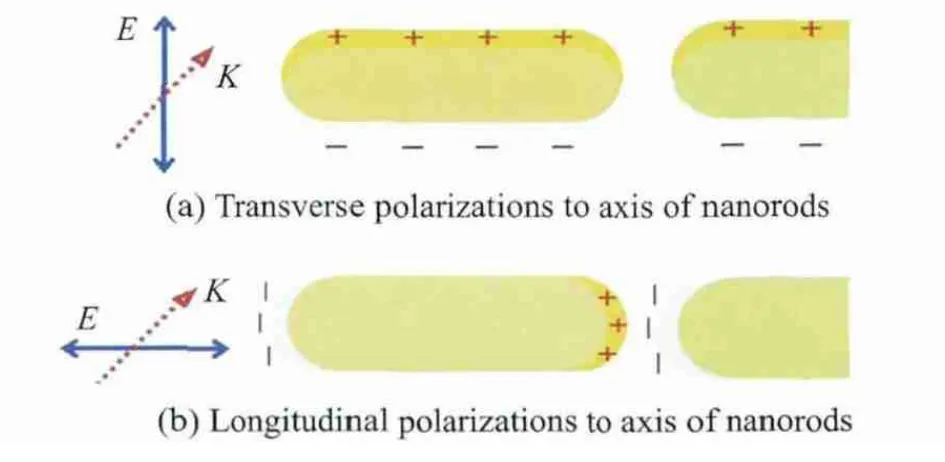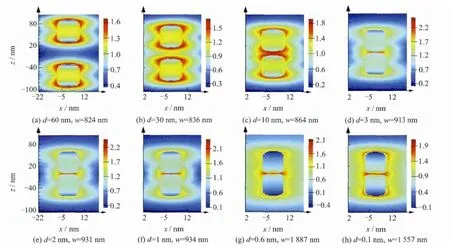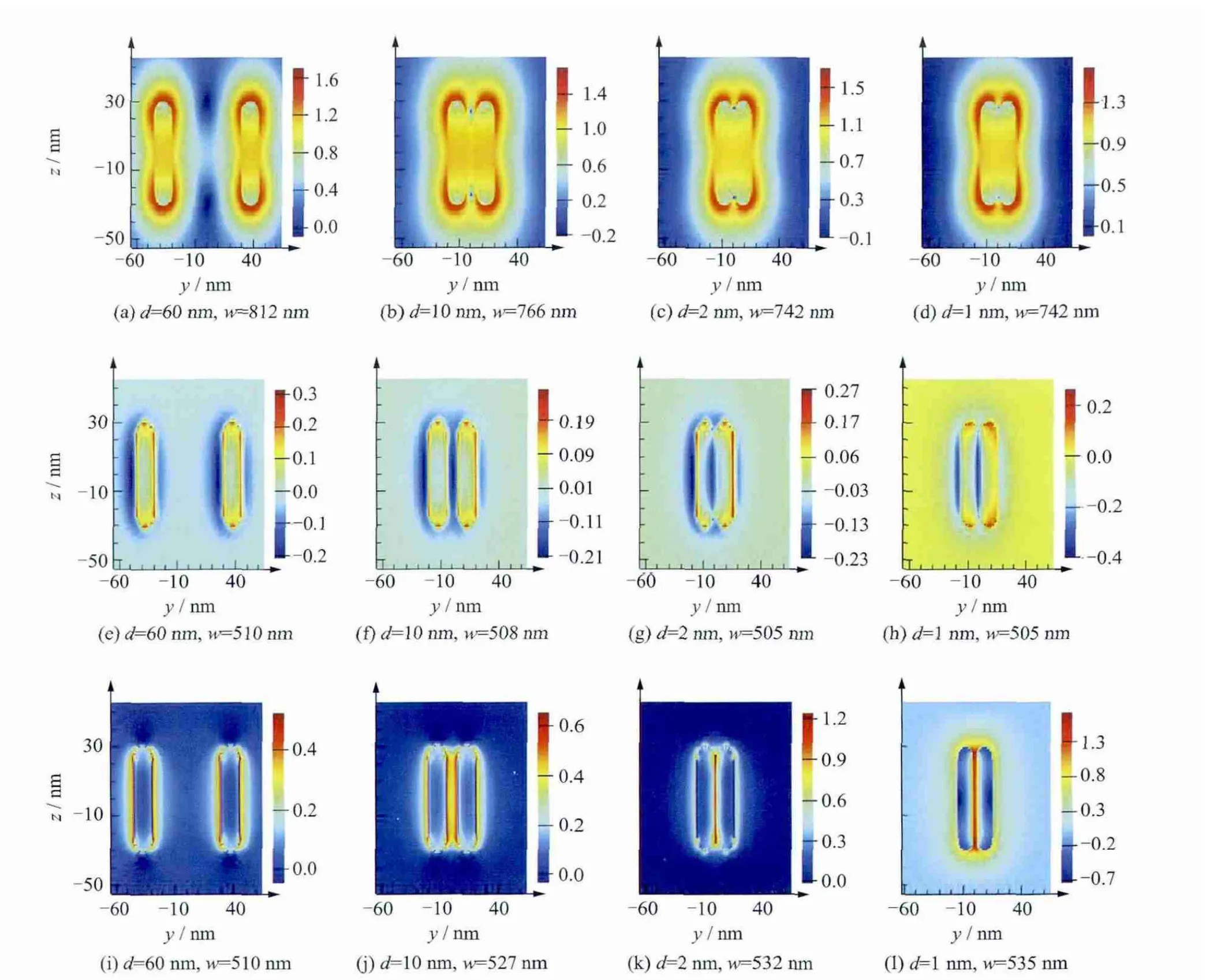FDTD Simulations on Plasmonic Properties of End-to-End and Side-by-Side Assembled Au Nanorods*
2014-04-24KanCaixia阚彩侠LiYuling李玉玲LiuJinsheng刘津升XuHaiying徐海英NiYuan倪媛
Kan Caixia(阚彩侠),Li Yuling(李玉玲),Liu Jinsheng(刘津升),Xu Haiying(徐海英),Ni Yuan(倪媛)
1.College of Science,Nanjing University of Aeronautics and Astronautics,Nanjing,210016,P.R.China;2.Key Laboratory for Intelligent Nano Materials and Devices of the Ministry of Education
1 Introduction
Noble metal nanostructures have been of an important research subject not only due to their unique and improved chemical and physical properties[1-4],but also motivated by their potential applications in fields of catalytic[5-7],optoelectronic[8,9],molecular diagnostics[10,11], and data storage[12,13]. From ancient time,gold(Au)colloid has been used to stain glass of wine red,mauve,blue and other colors.These effects are the result of changes in the surface plasmon resonance(SPR)absorption,at which the frequency of free electrons of metals oscillats in response to the alternating electric field of incident electromagnetic radiation[14].
The optical properties of small metal particles have inspired many researchers in the past century.The interaction between the incident electromagnetic wave and a nonspherical metal nanoparticle can be described by the radiation of a lossy dipole induced at the center of the particle.Assuming the scattering and higher order polarization terms are negligible.The first theoretical framework to fully explain this peculiar interaction between light and matter(for the case of spherical particles)was published by Mie in 1908[15].Then the theory was developed,for example,Gans functions,to calculate the optical resonance of ellipsoids and rod[16].With the development of colloidal chemistry,noble nanostructures of various morphologies can be obtained in experiment.More and more investigations show that the optical property of metal nanocrystals depends highly on the morphology of nanostructures.For example,two distinctive plasma resonances usually appear for Au nanorod:a strong longitudinal surface plasmon resonance(SPRL)shifting in the visible-near infrared(Vis-NIR)region with increasing aspect-ratio of Au nanorod and a weak transverse surface plasmon resonance(SPRT)located at about 520 nm[17-19].Pd nanocubes and nanorods exhibit resonant peaks in the region of 330—870 nm in the absorption spectra,whereas the spherical Pd nanoparticles have no resonance in the Vis-NIR region[20].
In the synthesis of nanomaterials through chemical methods,nanoparticles can usually be organized into well-defined assembly due to the adsorption of polar group,static electricity,soft template,and changes of surface tension in the solution.Moreover,with the development of nanotechnology,nanoparticle monomer is required to assembly into functional unit.For instance,in the excitation of electronic field,compared with the surface-enhanced Raman effection of isolated Au nanoparticle,the assembled Au nanoparticles dimmer and multimer will lead to redistribution of surface charge and strong near field coupling effect in the nanogap[21,22].However,for the measured optical absorption spectra,the SPR properties are an average effect of various nanostructures.Therefore,one needs to make clear the SPR property of a certain assembly under different excitations of electronic field.Near-field optical technology provides one expensive experimental method,and another method is simulation based on electromagnetic field theory.
In the theoretical simulations,Gans function can not accurately reflect the optical properties of the nonrod or assembled system.In recent years,study on the optical properties of different shaped nanostructure has made great achievements by solving Maxwell equations depending on computer and kinds of numerical methods,including finite-difference time-domain(FDTD).FDTD method supplies a simple,convenient,systematic approach for calculating the optical response of nanostructures and their assembly with arbitrary symmetry and geometry by solving Maxwell's equations on discrete grids.
Herein,we describ the SPR coupling effect and local field distribution induced by Au nanorods dimer under different incident electronic field.Optical constant of dielectric permittivity with the wavelength adapts Johnson and Christy database attached with the FDTD.The background refractive index is 1.33,and perfect match layer boundary condition is implemented.Corresponding to the experimental results,the obtained Au nanorods with qusi-semispheres capped at two ending surfaces are calculated.As is shown in Fig.1,there are transverse and longitudinal polarizations to the rod axis.And two distinctive plasma resonances can be achieved when the metallic nanorods are irradiated by incident light.

Fig.1 Two polarizations of metallic nanorod under electric field
2 FDTD Simulated Results
The extinction spectra usually involve absorption and scattering.For the small sized Au nanorods used in our calculation(15 nm in diameter),the scattering intensity is very weak compared with that of the absorption,as shown in Fig.2(a).And only SPR absorption is considered in the FDTD simulation.For the optical absorption spectra of Au nanorods with different aspect ratios(see Fig.2(b)),in addition to a weak SPRTpeak localized at about 520 nm,as inserted in Fig.2(b)),there is a strong and tunable SPRLpeak shifting in the NIR range of 600—1 300 nm.The simulated spectra agree well with the experimental results,as previously reported[23,24].

Fig.2 FDTD simulated optical spectra of Au nanorod monomer
In the following simulation of Au nanorods assembly,the aspect ratio(AR)of nanorod is 4.Fig.3 shows the optical spectra of end-to-end(E-E)oriented Au nanorods dimmer.The results indicate that the SPRLred-shifts obviously with decreasing the gap spacing(see Fig.3(a)),and it is different from the SPRLof one nanorod monomer with doubled aspect ratio(for Au nanorod with AR=8,the SPRLis 1 288 nm,as shown in Fig.2(b)).While the SPRTof E-E oriented Au nanorods has no shifting(see inset of Fig.3(a)).When the gap spacing is 1 nm,a new and weak coupling SPR absorption appear at about 3 800 nm(the weak SPR is not shown here).When the gap spacing is 0.866 nm,this new SPR of Au nanorods assembly is located about 2 200 nm.With further decreasing the gap size,the location of coupling SPR blue-shifts and the intensity enhances.Simultaneously,the SPRLof E-E Au nanorods assembly blue-shifts from about 940 nm to about 780 nm,as shown in inset of Fig.3(b).
For the SPR shifting of E-E Au nanorods assembly,it can be explained according to the spring oscillator model[25].When the polarized light is applied perpendicular to the assembly direction,the interaction of two Au nanorods polarized charge does not affect the vibration of the nanorods along this perpendicular direction,which is responsible for the fixed SPRT,as inserted in Fig.3(a).When the polarized light is applied parallel to the direction of assembly,the attraction from the neighbouring Au nanorod decreases the restoring force of vibration with decreasing the gap spacing,which in turn reduces the SPR frequency of the Au nanorod.As a result,the SPRLof the E-E assemldy red-shifts in the spectra.When the gap spacing is less than 1 nm,the anticipated SPRLblue-shifting and the appearance of new coupling SPR of Au nanorods assemblies in a longer wavelength possibly depend on the strong coupling effect and tunneling effect of surface electrons.
Corresponding to the optical spectra,the localized electronic field of the E-E assembled Au NRs dimmer is obtained under the irradiation of corresponding SPR wavelength,as shown in Fig.4.When the gap is 60 nm,electronic fields of two Au nanorods have no obvious coupling effect and the position of SPRLis near the same position of one Au nanorod.With decreasing the gap size to 10 nm,coupling effect occurs in the gap.When the gap size is 1 nm,the gap field is divided into two parts,which should be responsible for the appearance of new SPR in the longer wavelength.With further decreasing the gap size,the electronic fields are enhanced in the gap and regions around the Au nanorods,which possibly accounts for the enhancement and blue-shifting of the new coupling resonance of E-E oriented Au nanorods.

Fig.3 Calculated SPR absorption spectra for E-E assembled with gap spacing

Fig.4 Electric field distribution of E-E oriented Au nanorods dimmer with decreasing gap spacing(d=60,30,10,3,2,1,0.6,0.1 nm)
Fig.5 is the FDTD simulated absorption spectra for S-S oriented Au nanorods dimer.Compared with SPRLfor Au nanorod monomer,the SPRLpeak position of S-S orients Au nanorods dimer blue-shifts obviously,as shown in Fig.5(a)(SPRLand SPRTof Au nanorod monomer with AR=4 are located at about 815 nm and 510 nm,see Fig.2(b)).It is quite clear that there are two SPRTpolarizations for S-S oriented Au nanorods dimmer.When the polarized light is applied perpendicular to the assembly direction(as inserted in Fig.5(b)),the SPRTblue-shifts slightly from about 510 nm to about 505 nm for the S-S orients Au nanorods dimer with gap 1 nm,as shown in Fig.5(b).When the polarized light is applied parallel to the assembly direction(as inserted in Fig.5(c)),the SPRTred-shifts obviously from about 510 nm to about 535 nm,as shown by Fig.5(c).

Fig.5 FDTD simulated absorption spectra for S-S oriented Au nanorods
Under the longitudinal polarization,the same polarization charge from Au nanorod heads does not affect the longitudinal resonance frequency.However,one end with negative charge will be affected by the positively charged end of another nanorod.Longitudinal vibration frequency of the S-S oriented Au nanorods dimer increases compared with that of single Au nanorod.As a result,the SPRLfor S-S oriented Au nanorods blue-shifts with decreasing the gap spacing.When the incident light perpendicular to the assembly,two transverse resonances appear for the S-S oriented Au nanorods.(1)The polarized light is applied perpendicular to the oriented direction of Au nanorods dimer,the SPRTblue-shifts very slightly with decreasing the gap spacing.(2)The polarized light is applied parallel to the oriented direction,the SPRTpeak red-shifts obviously with decreasing the gap spacing(or increasing the number)of nanorods,which is similar to the SPRLred-shifting of nanoparticle chain[21].
Corresponding to the optical spectra,the localized electronic field of the S-S orient Au nanorods dimer is also obtained under three different polarizations,as shown in Fig.6.Fig.6(a)is the localized electronic field for the S-S assembled Au nanorods dimer under longitudinal polarization.When the gap is 60 nm,electronic fields of two Au nanorods have no obvious coupling effect and the position of SPRLis near the same position of one Au nanorod.With decreasing the gap size,coupling effect occurs in the ending gap and SPRLblue-shifts,which is similar to that of“dog-bone”.When the polarized light is applied perpendicular to the assembly direction(as shown by the inset of Fig.5(b)),no obvious coupling effect occurs in the nanogap of Au nanorods dimmer with decreasing the gap size.When the polarized light is applied parallel to the oriented direction(as shown by the inset of Fig.5(c)),strong coupling effect occurs in the nanogap,leading to the enhancements of electronic field and red-shifting SPRTintensity with decreasing the gap size.
Compared with the experimental results of Au nanorods assembles,the measured SPR evolutions agree well with that of FDTD simulation.In the simulation process,the aspect ratio of Au nanorod is 4,and the S-S and E-E assembled Au nanorods are symmetrical in morphology.While the SPR properties obtained in experiment are an average effect of different polarizations on various Au nanorods dimmer,multimer and even monomer,as shown Fig.7.Moreover,the obvious coupling effect of electron field occurs when the gap is about 1 nm.It is not possible for experimental realization due to the chain length(1.5—2 nm)of applied linking molecular(as inserted in Fig.7). Asaresult,thenew couplingSPR in the longer wavelength,as predicted in simulation,can not be detected in experiments at present.

Fig.6 Electronic field distribution of S-S oriented Au nanorods with decreasing gap spacing

Fig.7 TEM images of linked Au nanorods with 1—2 nm spacing
3 Conclusions
We introduce the FDTD simulation on the SPR properties and localize electronic field of E-E and S-S oriented Au nanorods dimer.It is found that SPRLred-shifts for the E-E orients Au nanorods dimer and blue-shifts for S-S orients Au nanorods dimmer with decreasing the gap spacing.Moreover,a new coupling SPR appears for the E-E assembly in a longer wavelength region,blue-shifting and enhancing with further decreasing the gap spacing.For the SPRTproperty,there are two different transverse polarizations for the S-S oriented Au nanorods dimmer.The SPR shifting and the appearance of new coupling SPR of assembled Au nanorods dimer are explained by means of spring oscillator model and the polarized charge distribution on nanoparticles.
[1] Tian Na,Zhou Zhiyou,Sun Shigang,et al.Synthesis of tetrahexahedral platinum nanocrystals with high-index facets and high electro-oxidation activity[J].Science,2007,316(5825):732-735.
[2] Zijlstra P,Chon J W M,Gu M.Five-dimensional optical recording mediated by surface plasmons in gold nanorods[J].Nature,2009,459(7245):410-413.
[3] Romo-Herrera J M,Alvarez-Puebla R A,Liz-Marzan L M.Controlled assembly of plasmonic colloidal nanoparticle clusters[J].Nanoscale,2011,3(4):1304-1315.
[4] Banerjee A N,Joo S W,Min B K.Quantum size effect in the photoluminescence properties of p-type semiconducting transparent CuAlO2nanoparticles[J].Appl Phys,2012,112(11):114329.
[5] Wu Yuen,Wang Dingsheng,Li Yadong.Nanocrystals from solutions:Catalysts[J].Chem Soc Rev,2014,45(20):2112-2124.
[6] Klajn R,Pinchuk A O,Schatz G C,et al.Synthesis of heterodimeric sphere-prism nanostructures via metastable gold supraspheres[J].Angew Chem Int Edit,2007,46(44):8363-8367.
[7] Wang C,Daimon H,Onodera T,et al.A general approach to the size-and shape-controlled synthesis of platinum nanoparticles and their catalytic reduction of oxygen[J].Angew Chem Int Ed,2008,120(19):3588-3591.
[8] Zhou Baoping,Yu Gang,Ouyang Yuejun,et al.Electrodeposition of Pd-Ag alloy nanoparticle chains on carbon fibers and their hydrogen sensing properties[J].Acta Phys-Chim Sin,2010,26(1):237-243.
[9] Jin R C,Cao Y W,Mirkin C A,et al.Photoinduced conversion of silver nanospheres to nanoprisms[J].Science,2001,294(5548):1901-1903.
[10]Sanvicens N,Marco M P.Multifunctional nanoparticlesproperties and prospects for their use in human medicine[J].Trends Biotechnol,2008,26(8):425-433.
[11]Anker J N,Hall W P,Lyandres O,et al.Biosensing with plasmonic nanosensors[J].Nature Materials,2008,7(6):442-453.
[12]Haynes C,van Duyne R P.Plasmon-sampled surfaceenhanced raman excitation spectroscopy[J].Phys Chem B,2003,107(30):7426-7433.
[13]Haynes C,van Duyne R P.Surface raman spectroelectrochemistry,part I:Heterocyclic,aromatic and amines adsorbed on the anodized silver electrode[J].Electroanal Chem,1977,84(1):1-20.
[14]Quinten M.Optical properties of nanoparticle systems[M].Singapore:Wiley-VCH Verlag GmBH&Co KGaA,2011.
[15]Mie G.Beitr~ge zur optik trüber medien,speziell kolloidaler metallösungen[J].Annalen der Physik,1908,33(3):377-445.
[16]Gans R.über die form ultramikroskopischer goldteilchen[J].Ann Physik,1912,342(5):881-900.
[17]Li Hongcheng,Kan Caixia,Yi Zhaoguang,et al.Synthesis of one dimensional gold nanostructures[J].Journal of Nanomaterials,2010:1-8.
[18]Ke Shanlin,Kan Caixia,Mo Bo,et al.Research progress on the optical properties of gold nanorods[J].Acta Phys Chim Sin,2012,28(6):1275-1290.(in Chinese)
[19]Kan Caixia,Ni Yuan,Cong Bo,et al.Shape-controlled synthesisand photo-thermal conversion of gold and silver nanostuctures[J].Journal of Nanjing University of Aeronautics&Astronautic,2013,45(6):776-783.(in Chinese)
[20]Xiong Yujie,Cai Honggang,Wiley B J,et al.Synthesis and mechanistic study of palladium nanobars and nanorods[J].J Am Chem Soc,2007,129(12):3665-3675.
[21]Barrow S J,Funston A M,Gómez D E,et al.Surface plasmon resonances in strongly coupled gold nanosphere chains from monomer to hexamer[J].Nan Lett,2011,11(10):4180-4187.
[22]Funston A M,Novo C,Davis T J,et al.Plasmon coupling of gold nanorods at short distances and in different geometries[J].Nano Lett,2009,9(4):1651-1658.
[23]Wang Libing,Zhu Yingyue,Xu Liguang,et al.Sideby-side and end-to-end gold nanorod assemblies for environmental toxin sensing[J].Angew Chem Int Ed,2010,49(32):5472-5475.
[24]Liu J S,Kan C X,Li Y L,et al.End-to-end and sideby-side assembly of Au NRs induced by dithiol poly(ethylene glycol)[J].Appl Phys Lett,2014,104:253105.
[25]Wang Zhenlin.A review on research progress in surface plasmons[J].Progress in Physics,2009,29(3):287-324.(in Chinese)
猜你喜欢
杂志排行
Transactions of Nanjing University of Aeronautics and Astronautics的其它文章
- Microwave Photonics for Modern Radar Systems*
- Fast SSED-MoM/FEM Analysis for Electromagnetic Scattering of Large-Scale Periodic Dielectric Structures*
- Focus Reflective Shock Wave Interaction with Flame
- Geometric Covariance Modeling for Surface Variation of Compliant Parts Based on Hybrid Polynomial Approximation and Spectrum Analysis*
- Tunable Electromagnetic Cloaking by External Field
- Parallel-Computing Wavelet-Based FDTD Method for Modeling Nanoscale Optical Resonator
